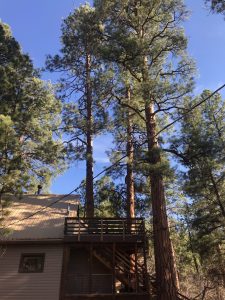 It started, as these things always do, by answering my phone. I never know what to expect when it rings—it could be someone who wants a tiny bush trimmed, or a telemarketer, or maybe someone with something much more interesting for me. This young man was calling to find an arborist willing to drive out to his grandfather’s cabin on Mount Taylor just outside Grants, New Mexico, to remove a couple of ponderosa pines. The only thing was, grandpa thought it would be real keen to build his cabin around two of the ponderosas on his property. AROUND the trees! The trees were incorporated into the deck and the entry way. So the larger tree was actually inside of the house for a story and a half. The holes had to be made larger from time to time as the trees grew and grew, and grew. After three remodels and grandpa’s passing the family decided it was finally time for those trees to go, but by then the larger pondy was 125 feet tall (measured, not guessed) and the smaller one was only 115.
It started, as these things always do, by answering my phone. I never know what to expect when it rings—it could be someone who wants a tiny bush trimmed, or a telemarketer, or maybe someone with something much more interesting for me. This young man was calling to find an arborist willing to drive out to his grandfather’s cabin on Mount Taylor just outside Grants, New Mexico, to remove a couple of ponderosa pines. The only thing was, grandpa thought it would be real keen to build his cabin around two of the ponderosas on his property. AROUND the trees! The trees were incorporated into the deck and the entry way. So the larger tree was actually inside of the house for a story and a half. The holes had to be made larger from time to time as the trees grew and grew, and grew. After three remodels and grandpa’s passing the family decided it was finally time for those trees to go, but by then the larger pondy was 125 feet tall (measured, not guessed) and the smaller one was only 115.
EMBED VIDEO HERE IMG_2070
My interest being peaked, I agreed to head out to Grants, a mere 150 miles from Taos. Somehow, I made it all the way to Grants without seeing Mt. Taylor, but it was there waiting for me as I headed north from town, past acres and acres of apparently empty green houses next to the various houses of incarceration. What a sight to behold when I pulled up the long, narrow, and steep driveway. These trees were massive, and as beautiful as they were one could immediately see why they had to go. Figuring out how to get these trees down safely was really fun as these were quite possibly the largest and most challenging trees that any tree service had to remove that year in the whole state.
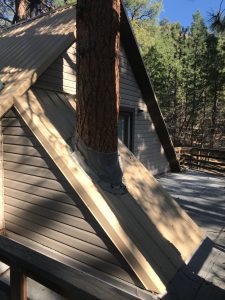
We had to stay in Grants so we could work full days without all the driving, so we got to see lots of Grants. I highly recommend visiting Grants. Good food, good beer, good times. The plan was to climb the two pondys and use a zip-line rigging system to remove all the branches on the way up to the top. Once there, a mere 120 feet up for the bigger one, we would negative block the tops to the spars and work the wood down in this same way until we were too close to the roof to safely take another piece. Then we would have to employ a 20-ton crane to get the wood out of there and safely lifted through the holes in the house and deck. Sounds easy enough right?
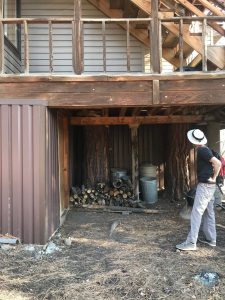
The first days drive went well, we got to the hotel and made merry. The second day we began working the branches off our trees, but the wind was too sporadic and gusty to safely climb to the tops. We had to call it a day early when the rain finally came in. We promise we will always call it a day when the weather turns bad for the safety of our crew and your property, even if it is annoying that we have to come back. The next day we were able to finish the climbs, Sancho in the big tree, and me in the small one. Sancho claims not to be afraid of heights, and she seems to be tickled by them so being that I am quite afraid of heights I let her take the bigger tree. She went all the way to the top, 120 feet up, where the tree was only 5 inches in diameter, she rigged the top and made the cut! She is so amazing.
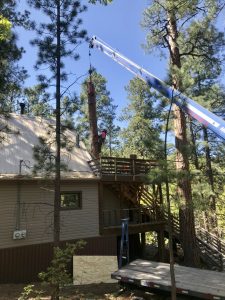
I on the other hand am so wimpy that I could only make myself climb up about 100 feet before I started becoming very very nervous, just another mere mortal swaying back and forth way above the top of the cabin. I decided to change my plan and not negative block my top but instead throw the 15 foot top from there, free falling it and hoping that it would clear the side of the deck. What a wimp, you would agree if you could have heard the noises I made, kinda like a really pathetic pig squeal, but with a jazzy touch of giggles and caterwauls. But at least I was on my way down.
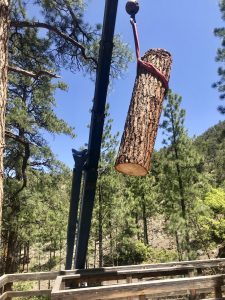
We took a little longer than we thought we might getting down to where we needed to be for the crane, but the zip-line rigging technique worked famously. Sancho still had a little more wood to do so I went to town to meet the crane. When I got to the hotel I was bummed to see the crane wasn’t there because the day was mostly gone. I was worried we wouldn’t be able to finish it that day and then the crane pulled in and I felt my stomach turn. Keeping the feeling down I went to greet the crane operator and tell him he brought the wrong machine. The crane service sent out a 40-ton crane, which the operator assured me would do anything a 20-ton could do, in fact they suggested it might even be better. The thing was, we needed a 20-ton crane because it was SMALL enough to get up the driveway which would be hard enough, but also the area to deploy a crane must be level and the area at the top of the driveway would barely be large enough for the 20-ton to deploy. The 40 ton with it’s much larger footprint would have to make the trip back to Albuquerque, and we would have to enjoy another night in Grants.
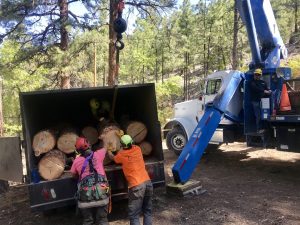
IMG_2069 EMBED VIDEO HERE
The next day, the proper machine came out and we were able to pick those huge logs from inside of the cabin. I’d never before in my life had the privilege of cutting with a chainsaw indoors! I don’t recommend it however, as the fumes get pretty bad. One of the neighbors was interested in taking the wood for firewood so we carefully loaded up each long piece in our trucks and hauled them down the road.
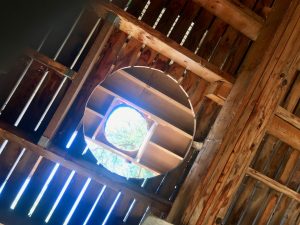
Overall, this was one of the most exciting tree removal jobs I’ve ever had the pleasure of undertaking in New Mexico! When you have a dangerous tree removal that is stumping you and your local tree services just won’t cut it, call the pros with the experience you can trust to get even the most challenging job done safely. Call Baby Gorilla Tree Service today for your free estimate.
IMG_2068 EMBED VIDEO HERE
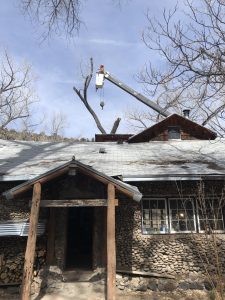 Some of you may be lucky enough to know of this lovely place along the Rio Grande called “the rock house”. My friends live there and are just the most warm and wonderful people you could ever meet. Like many New Mexicans, these acute and resourceful folks are used to solving problems and doing all kinds of jobs, even if they haven’t done it before. They really are good too–professional grade in all ways. So I was surprised to hear from them about a little old tree.
Some of you may be lucky enough to know of this lovely place along the Rio Grande called “the rock house”. My friends live there and are just the most warm and wonderful people you could ever meet. Like many New Mexicans, these acute and resourceful folks are used to solving problems and doing all kinds of jobs, even if they haven’t done it before. They really are good too–professional grade in all ways. So I was surprised to hear from them about a little old tree.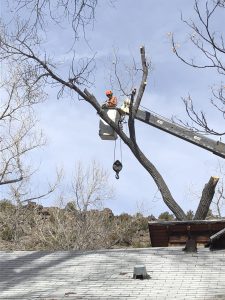 kay it wasn’t a small tree. It was a large cottonwood that had been uprooting towards the house. Maybe it wasn’t going to come down that week, but some unlucky day it would fall onto the house. We agreed that it was already a difficult tree to remove and it would only keep growing. My friends decided it would be best for us to remove it.
kay it wasn’t a small tree. It was a large cottonwood that had been uprooting towards the house. Maybe it wasn’t going to come down that week, but some unlucky day it would fall onto the house. We agreed that it was already a difficult tree to remove and it would only keep growing. My friends decided it would be best for us to remove it.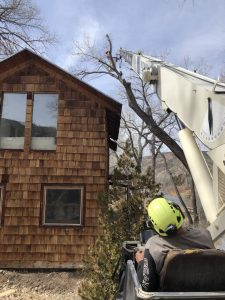 Once in position all we had to do was get really high in the air in a wiggly crane bucket that pivots freely under your feet in a distinctly unpleasant way when you lean one way and pivots back when you lean the other way. Some people, including Baby Gorillas, enjoy this sort of thrill, but one has to set one’s glee aside to focus on the very serious job at hand—methodically taking the tree down branch by branch.
Once in position all we had to do was get really high in the air in a wiggly crane bucket that pivots freely under your feet in a distinctly unpleasant way when you lean one way and pivots back when you lean the other way. Some people, including Baby Gorillas, enjoy this sort of thrill, but one has to set one’s glee aside to focus on the very serious job at hand—methodically taking the tree down branch by branch.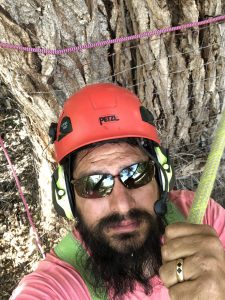 Our arborists stay in constant communication with the crane operator for safety using bluetooth communication devices in our hardhats. Even when using chainsaws and heavy equipment sometimes 100 feet or more apart our technicians can just speak normally into their noise canceling microphones.
Our arborists stay in constant communication with the crane operator for safety using bluetooth communication devices in our hardhats. Even when using chainsaws and heavy equipment sometimes 100 feet or more apart our technicians can just speak normally into their noise canceling microphones.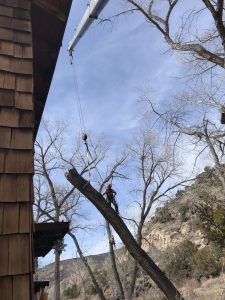
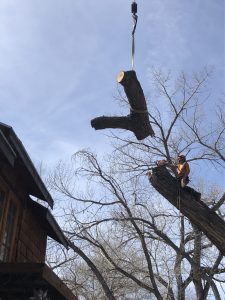
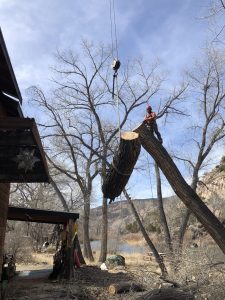







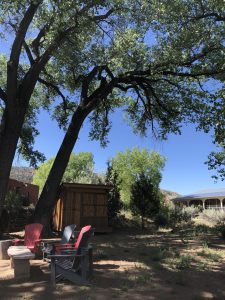
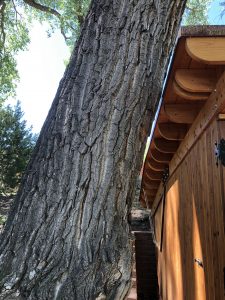
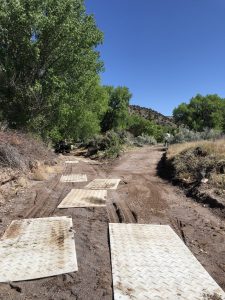
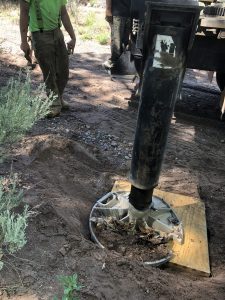
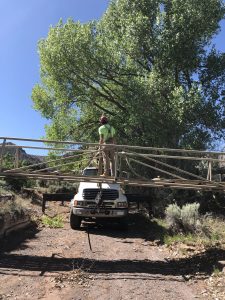
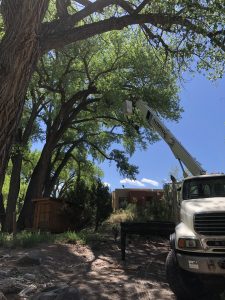
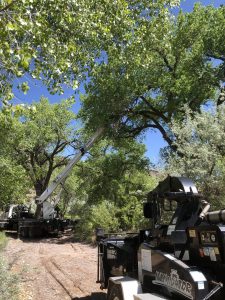
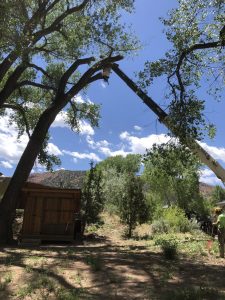
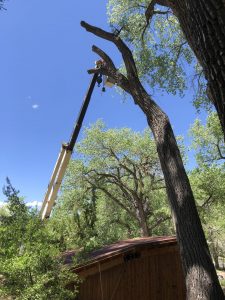
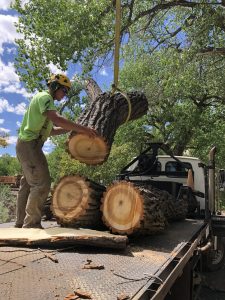
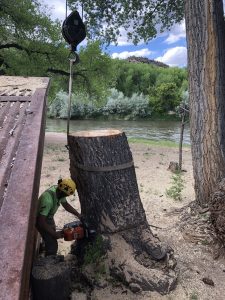
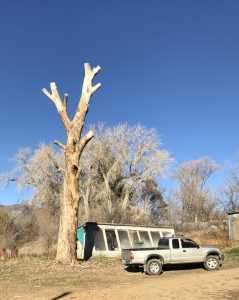
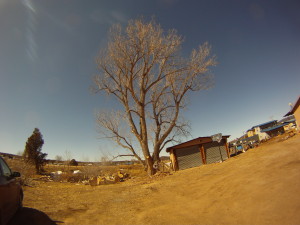
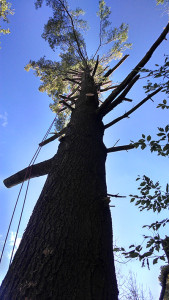 As with most tree troubles, there is no way to diagnose without first identifying the species, taking a first hand look at the site and obtaining a full history, however I am highly suspicious that your tree may be infested with the Douglas-fir Tussock Moth. The Douglas-fir Tussock Moth affects Douglas-fir, white fir, and blue spruce in Northern New Mexico, and can easily remove all foliage in a few years, usually starting at the top. The overwintered eggs hatch from mid May to early June and the baby caterpillars feed on the new growth. They are compelled to climb as high as they can to release a silk parachute to carry them away in a breeze in hopes of finding a new host tree, but most perish on the journey. This compulsion of the young to climb upward may be what causes just the top of the tree to die, but it is actually the mature Tussock Moth that does the most damage which can kill the rest of the tree.
As with most tree troubles, there is no way to diagnose without first identifying the species, taking a first hand look at the site and obtaining a full history, however I am highly suspicious that your tree may be infested with the Douglas-fir Tussock Moth. The Douglas-fir Tussock Moth affects Douglas-fir, white fir, and blue spruce in Northern New Mexico, and can easily remove all foliage in a few years, usually starting at the top. The overwintered eggs hatch from mid May to early June and the baby caterpillars feed on the new growth. They are compelled to climb as high as they can to release a silk parachute to carry them away in a breeze in hopes of finding a new host tree, but most perish on the journey. This compulsion of the young to climb upward may be what causes just the top of the tree to die, but it is actually the mature Tussock Moth that does the most damage which can kill the rest of the tree.